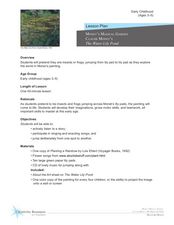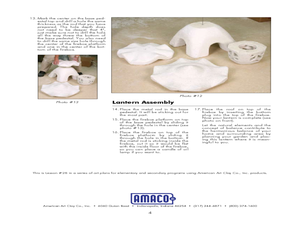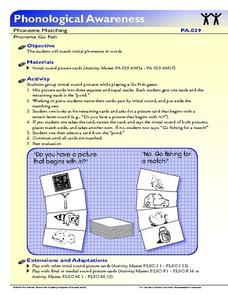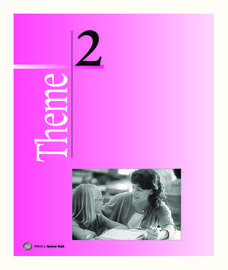Curated OER
Monet's Magical Garden
Students study classic paintings by masters like Monet. In this art history lesson, students listen to the story Planting a Rainbow by Lois Ehlert and sing flower songs with the rest of their class. Students examine the painting The...
Curated OER
Creating a Pond Habitat
Students create a pond habitat inside and outside their classroom. In this pond lesson plan, students create a habitat with animals, water, and plants in order to create a proper pond habitat.
Curated OER
Garden Pests & Problems: Toad Town
In this garden pests & problems toad town instructional activity, students read and follow directions for building a home and a pond for a toad to help with insect control in a garden.
Curated OER
Creating a Japanese Garden Lantern in Crea-Stone
Students create a Japanese Garden Lantern. In this step-by-step ceramics instructional activity, students follow simple how-to directions to mold and create a Japanese Garden Lantern out of Crea-Stone.
Curated OER
Growing Fruit: Berry Funny!
In this growing fruit berry funny worksheet, students write a list of berry names, then complete 5 funny sentences about berry names.
Curated OER
Painting - Science Integration - Ponds - Monet - Painting
First graders identify Monet as an Impressionist artist. They create impressions of trees and bushes, paint with sponges, and mix tints and shades. They create impressions of flowers with q-tip dabbing and mixing tints and shades.
Curated OER
Observing Buffers In Lakes, Ponds And Streams
High schoolers observe the effects of limestone on the acidity of water. Some areas of the nation have a lot of limestone in lake bottoms and in soil, which helps neutralize the effects of acid rain. Students see this effect first hand.
Curated OER
Landscaping for Wildlife
Students identify the essential elements needed for promoting wildlife habitat. They describe the terms used in habitat design and the shelter for wildlife. Students explore how to create a pond to support wildlife and how to create a...
Curated OER
NGA Kids Inside Scoop Spring 2007
Students become familiar with the work of Claude Monet and his garden paintings. In this Monet instructional activity, students compare the garden works of Claude Monet. Students examine pictures for the colors in his...
Curated OER
Food Chains
In this food chain worksheet, students draw in a food web for 6 different habitats: woodland, garden, pond, sea, arctic, and desert. This worksheet is a graphic organizer.
Curated OER
Hummingbirds and Flowers: A Study of Co-Adaptive Relationships
Hummingbirds and flowers need each other to survive! Pupils explore the co-adaptation of hummingbirds and the flowering plants. They explain how a flowering plant has adapted to be pollinated by a hummingbird and how the hummingbird has...
Curated OER
Spud Smear
Students study various samples of microorganisms in petri dishes. In this microorganism lesson, students place various samples of items in petri dishes and observe them after several days of incubation.
Curated OER
Mini-Ecosystems
Students use plastic bottles to create terrariums and plant Venus Flytraps. They observe the plants and the terrariums for illustrations of the water cycle and species' adaptations to a specific environment.
Curated OER
Animal Homes
Match animals to their environments with a cute lab activity. Kids draw a line between each animal, such as a fish, a rabbit, and an ant, to the place where it lives. For hands-on practice, a science investigation instructs learners to...
Florida Center for Reading Research
Phonological Awareness: Phoneme Matching, Phoneme Go Fish
Go fishing for initial sounds with this engaging phoneme game! Similar to the card game Go Fish, pairs use picture cards and try to match initial sounds. They set aside any pictures that are a match and ask their partner for specific...
Calvin Crest Outdoor School
Survival
Equip young campers with important survival knowledge with a set of engaging lessons. Teammates work together to complete three outdoor activities, which include building a shelter, starting a campfire, and finding directions in the...
Curated OER
Reading Comprehension 4: Level 7
Make an impression with a reading comprehension assessment based on Claude Monet. After reading a short biographical paragraph about the famous French painter, readers demonstrate their comprehension skills by drawing inferences,...
Teach-nology
Perfect Plurals
Turkeys/turkeyes. Deer/deers. Foots/feet. This fill-in-the-blanks worksheet asks learners to select the form of the noun that correctly completes each of the provided sentences.
Cornell University
Beneficial Insects
A lot of people think of insects as pests. But actually, some insects are beneficial because they get rid of pests! After learning about beneficial insects, class members research given insects to find out if they are pests or predators.
Dick Blick Art Materials
Peace Windows
Peace, love, tolerance, faith. Marc Chagall's Peace Window in the United Nations World Headquarters serves as a model for young artists as they create their own peace-themed transparent paintings. A great activity for both SPED and...
Curated OER
Tangerine: Vocabulary
Here's a great way to make vocabulary words drawn from Edward Bloor's novel Tangerine memorable. Kids create a word square, and in one quadrant write the word. A picture goes in a second quadrant, the definition in a third, and a...
Houghton Mifflin Harcourt
Nature Walk: Extra Support Lessons (Theme 2)
Reinforce concepts such as long vowels, spelling patterns, sound clusters, double-final consonants, and syllables with a nature-themed unit. Through a series of extra support lessons, learners compare and contrast using a...
Curated OER
A Tale of Two Wetlands
Students observe 2 separate wetlands (following downloadable worksheets) and record 10 similarities and 10 differences between them. Then they present their recommendations to the class who roleplay the government's wetland conservation...
Curated OER
The Great Water Hunt
Students examine a globe to locate the bodies of water present and create a representation of those bodies of water for further exploration of the concept. Extensions of their observations are made at school, home, and the community.

























